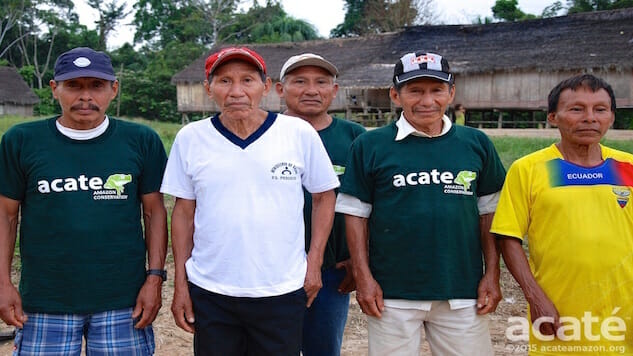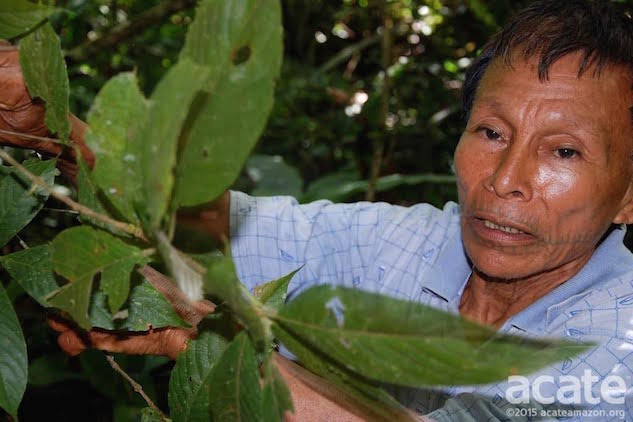EarthRx: Indigenous People Are Saving the Rainforest Just by Living in It
Photos courtesy of Acate Amazon Science Features Amazon Rainforest
According to experts, 80,000 acres of tropical rainforest are lost around the world every day to deforestation. Here in the Amazon, the largest and most biodiverse of the world’s tropical forests, 20 percent of the tree cover has disappeared in the last 40 years alone and scientists predict that 20 percent more will be gone in half that time in the years to come.
We are creating a wasteland earth for our children to inherit.
To make the problem worse, many top environmental outlets are still publishing confusing information about what is driving this crisis, including blaming the poor instead of confronting corporate greed. Of course the poor are not the real problem, and many cases they are the only thing standing in the way of the destruction.
Case in point: The Matsés Tribe of Peru
“Not including their territories in Brazil, the traditional lands of the Matsés in Perú comprise over 3 million acres of intact rainforest, including several major ecological zones that harbor amongst the highest biodiversity levels and carbon dense forests in the country.” Says Christopher Herndon, M.D., President and Co-founder of Acate Amazon, a conservation organization that works with the Matsés here in the Peruvian Amazon in an on-the-ground setting.
“It is critical to understand that the preservation of these lands is not a result of passive inhabitation by the Matsés, but rather from an active protection of their homelands and resistance to encroachment and resource extraction by outsiders.” he says.
According to Herndon and the Acate Amazon staff, the best way we can preserve the rainforest is to actually conserve and promote the traditional cultures that have been living there for millennia—they are the best guardians possible.
“It is no coincidence that the remaining tracts of intact rainforest in the Neotropics overlap closely with areas of indigenous habitation” he says, “Tribal peoples understand and value the rainforest because they are dependent upon it.”
“This relationship extends beyond a utilitarian reliance; there is a spiritual link to the forest, a sense of interconnectivity that is difficult to comprehend through the compartmentalized Western mindset but real nonetheless.”
Very real. In fact, According to the World Resources Institute (WRI.org), there is much less deforestation in areas of the rainforest that are both occupied and managed by local communities.
Using a state-of-the-art online forest monitoring system called Global Forest Watch, the institute used satellite imagery to show that indigenous and local communities of the rainforest often look like islands of intact treecover in areas that are surrounded by destruction and desolation.
This exactly why protecting the Matsés, who are an ancient culture known for their expert hunting skills and extensive knowledge of herbal medicine but are facing high levels of displacement, is the best way to protect the vast area pristine Amazon rainforest that they inhabit.
 Photo courtesy of Acate Amazon
Photo courtesy of Acate Amazon
“The Matsés still live by hunting, fishing and farming only now they live in family homes in permanent villages instead of living in communal longhouses in temporary villages.” Says Acate Amazon director and co-founder Willian Park.
“The biggest threats they now face are rapidly progressing acculturation and too many young people leaving for the cities. Fortunately, all the Matsés still speak their language and they were able to maintain a lot of their traditional territory in comparison to other indigenous groups,” Park says. “So, although they face serious challenges, they also have great opportunity to proactively protect their culture and the future for their people.”
This is why Acate Amazon was formed—to try to help the Matsés retain their traditional lands and culture in the face of fast globalization and encroaching exploitation. To that end, Acate has come up with a three pillared solution to empowering the locals in both the short and long term.
“Self-sufficiency is the unifying theme of Acaté’s three programmatic areas or pillars: sustainable economy, traditional medicine, and agriculture,” Park says. “All of our projects are interlinked with these pillars which are based on what the Matsés told us their greatest needs were before we formed Acaté.”
Realizing that the most powerful draw away from traditional living ways is simply monetary—the lure of fast cash in the big city—the first of Acate’s pillars is a economic solution based around the sustainable production of copaiba and sangre de grado, rainforest tree resins with incredible medicinal properties that give the Matsés a product with an already existing market they can trade and sell on.
Because both resins can be tapped from trees—much like maple syrup—there is no need to cut down the forest at all to produce these valuable products and Acate helps the tribe get fair prices and access to larger markets. In other words, it gives the Matsés sustainable jobs that keeps them in the rainforest.
According to Parks, another concern of the Matsés is that “the young people were not learning traditional knowledge, including the healing knowledge of their elders.”
The traditional knowledge of the Matsés elders is an extensive pharmacology that has been passed down from generation to generation from time immemorial and is the culmination of wisdom of the entire culture. With the youth leaving the Matsés territory at alarming rates, the chain may be broken and the wisdom of the entire tribe lost in this generation.
Besides helping the Matsés to form an apprenticeship program that matches youth with an elder in order to continue the shamanic lineage and traditional, the organization also assisted the tribe in writing a 500-page encyclopedia of traditional knowledge in their own language – a story that made a big headline splash in the environmental media when it broke but is really meant for future generations and not for outside cultures.
With the assistance of Acate, the Matsés are also creating medicinal forests that border their settlements and serve as sanctuaries for some of the most powerful and threatened plants. This is happening alongside the third pillar of the program, which is a permaculture agroforestry project that will give the Matsés more sustainable access and control over their own food.
“As the Matsés pass on their traditions, their traditions of caring for the land and each other will continue.”
Because the rainforest is not just home to the Matses, but to the fresh water and oxygen producing trees and rivers that the whole world depends on we all should be helping to keep these traditions alive for the sake of our own future generations.
“I think the Matses have already been benefiting the rest of humanity not only through the massive carbon stores and biodiversity they guard in their forests and by the clean rivers that flow out of their territory but also by what they represent to the world as a self-sustaining culture that has managed to persevere for so long.” Says Parks.
In other words, until the rest of us figure out how to live in harmony with the earth, one of the best ways we can help stop the environmental crisis is support the traditional cultures that do.
Images courtesy of Acate Amazon
Ocean Malandra writes the EarthRx Column for Paste Magazine and divides his time between the Redwood Forest of Northern California and the Amazon jungle of South America.